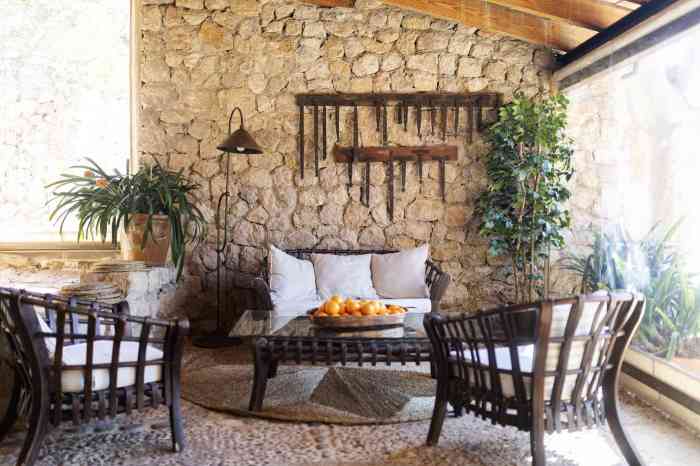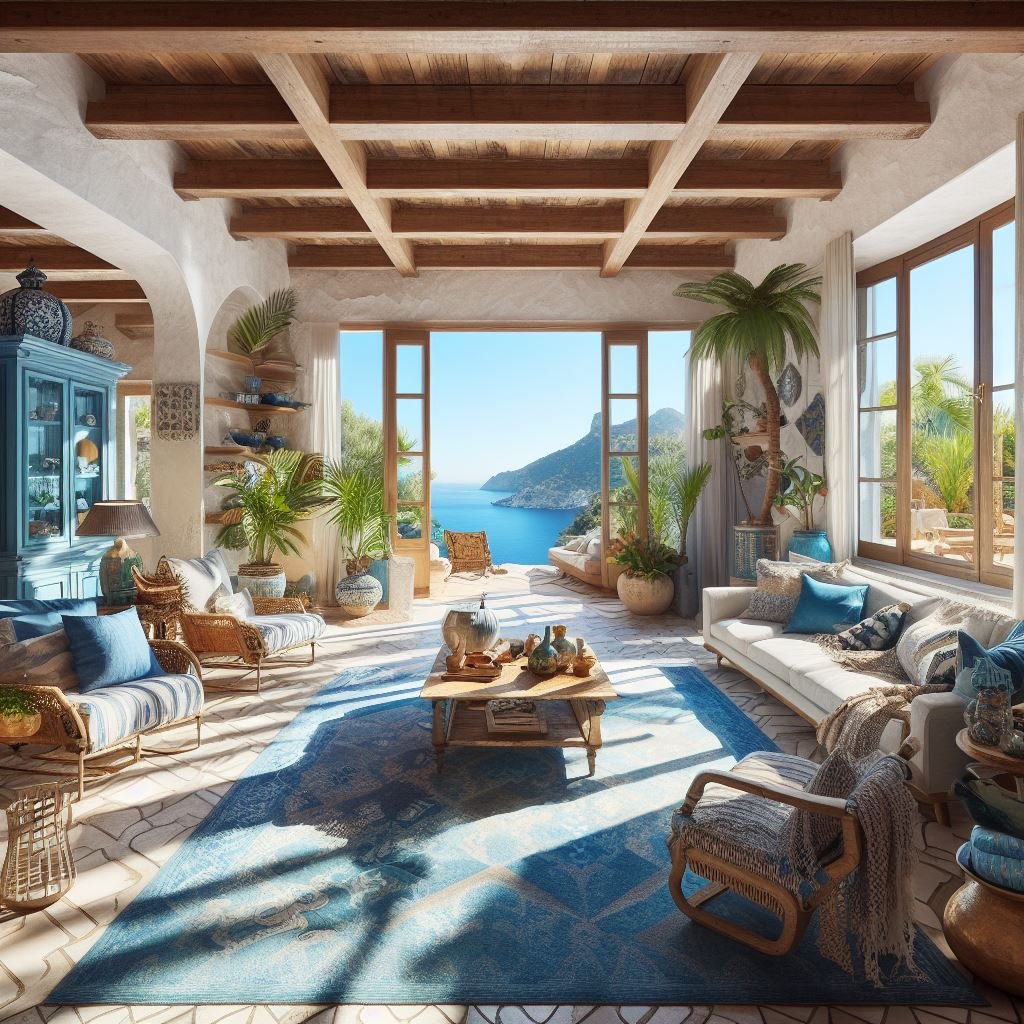Exploring the Essence of Mediterranean Interior Design
Embark on a journey through the captivating world of Mediterranean interior design, where warmth, elegance, and timeless beauty converge to create stunning living spaces. From the vibrant color palettes to the intricate furniture details, discover the key elements that define this iconic style.
What is Mediterranean Interior Design?
Mediterranean interior design is a style inspired by the coastal regions of Southern Europe, encompassing countries like Spain, Italy, and Greece. It is known for its warm and inviting aesthetic that captures the essence of the sea, sun, and sky.
Key Characteristics of Mediterranean Interior Design
- Earthy Tones: Mediterranean interiors often feature warm, earthy colors like terracotta, sandy beige, and olive green.
- Natural Materials: Wood, stone, and wrought iron are commonly used in Mediterranean design to create a rustic and organic feel.
- Architectural Details: Arched doorways, exposed wooden beams, and decorative tiles are signature elements of Mediterranean interiors.
- Textured Fabrics: Linen, cotton, and wool in rich, textured weaves add depth and coziness to Mediterranean spaces.
- Warm Lighting: Soft, golden lighting enhances the warm and welcoming atmosphere of Mediterranean interiors.
Color Palette in Mediterranean Interior Design
The color palette in Mediterranean interior design is inspired by the natural elements of the region, including the sea, sky, and earth. Common colors include:
- Earthy tones like terracotta, sandy beige, and olive green
- Cool blues and turquoise reminiscent of the Mediterranean Sea
- Warm yellows and golds reflecting the sunny climate
- Rich reds and oranges inspired by Mediterranean flora and sunsets
Materials and Textures in Mediterranean Interior Design
Mediterranean interior design incorporates a variety of materials and textures that evoke a sense of warmth and tradition. Some common examples include:
- Terra cotta tiles on floors and walls
- Wrought iron accents on furniture and light fixtures
- Wooden furniture with a distressed or weathered finish
- Textured fabrics like linen, cotton, and wool for upholstery and drapery
- Stone accents and mosaics in kitchens and bathrooms
Elements of Mediterranean Interior Design
When it comes to Mediterranean interior design, there are several key elements that define this style and create a warm and inviting atmosphere in a space. From arches and columns to rustic furniture and natural light, each element plays a crucial role in bringing the Mediterranean aesthetic to life.
Arches and Columns
In Mediterranean interior design, arches and columns are commonly used architectural features that add a sense of grandeur and elegance to a space. Arches can be found in doorways, windows, and even built-in shelving, while columns are often seen in open floor plans to divide spaces while maintaining a sense of openness.
Natural Light and Open Spaces
Natural light is a fundamental element of Mediterranean interior design, as it helps to create a bright and airy feel in the space. Large windows, French doors, and skylights are often incorporated to maximize the amount of natural light that enters the room.
Open spaces are also essential, allowing for a seamless flow between indoor and outdoor living areas.
Indoor Plants and Greenery
Mediterranean interior design embraces the use of indoor plants and greenery to bring a touch of nature indoors. Olive trees, citrus plants, and succulents are commonly found in Mediterranean-inspired spaces, adding a pop of color and life to the decor.
Whether displayed in terracotta pots or woven baskets, indoor plants help to create a relaxed and inviting atmosphere.
Color Schemes in Mediterranean Interior Design

When it comes to Mediterranean interior design, color schemes play a crucial role in capturing the essence of the region's sun-drenched landscapes and vibrant culture. The warm and earthy tones combined with shades of blue and green reflect the colors of the Mediterranean sea and surrounding nature, creating a sense of tranquility and relaxation within the space.
Warm and Earthy Tones
The use of warm and earthy tones such as terracotta, ochre, and sandy beige are characteristic of Mediterranean interior design. These colors evoke the natural elements of sun-baked clay, sandy beaches, and rustic landscapes, bringing a sense of warmth and coziness to the space.
Blues and Greens
Incorporating shades of blue and green into the color palette is essential to reflect the hues of the Mediterranean sea and lush vegetation. From deep navy blues to vibrant turquoise and seafoam greens, these colors add a refreshing and rejuvenating touch to the interior, creating a harmonious connection with the outdoor environment.
White and Neutral Tones
White and neutral tones such as crisp white, creamy ivory, and soft taupe are used to balance out the rich and bold colors in Mediterranean interior design. These light hues help to create a sense of airiness and openness, reflecting the bright sunlight and whitewashed buildings typical of Mediterranean architecture.
The combination of white and neutral tones with warm earthy colors and blues and greens results in a harmonious color scheme that captures the essence of the Mediterranean lifestyle.
Furniture and Decor in Mediterranean Interior Design

In Mediterranean interior design, furniture and decor play a crucial role in creating a warm and inviting atmosphere that reflects the essence of the Mediterranean region.When it comes to furniture styles in Mediterranean interior design, you'll often find pieces made of materials like wrought iron, wood, and mosaic tiles.
These materials not only add a rustic and earthy feel to the space but also bring in a sense of history and tradition.
Incorporating Ornate Detailing and Intricate Patterns
Incorporating ornate detailing and intricate patterns in decor is key to achieving the Mediterranean aesthetic. From ornate wood carvings to intricate mosaic tile work, adding these elements can elevate the overall look of the space and create a sense of luxury and elegance.
- Opt for furniture pieces with intricate carvings and details, such as armoires, tables, and chairs.
- Use decorative elements like wrought iron accents, intricate tile work, and hand-painted ceramics to add visual interest to the space.
- Choose textiles with bold patterns and rich textures, such as tapestries, rugs, and throw pillows, to enhance the Mediterranean vibe.
Use of Ceramics, Pottery, and Textiles
Ceramics, pottery, and textiles are commonly used in Mediterranean interior design to add color, texture, and a sense of authenticity to the space. These elements bring a touch of the Mediterranean lifestyle into your home and create a cozy and welcoming environment.
- Display hand-painted ceramics and pottery in shelves and cabinets to add a pop of color and a touch of craftsmanship to the space.
- Incorporate textiles like Moroccan rugs, tapestries, and embroidered fabrics to add warmth and softness to the room.
- Use decorative pillows, throws, and curtains with intricate patterns and bold colors to create a vibrant and inviting atmosphere.
Lighting and Accessories

In Mediterranean interior design, lighting and accessories play a crucial role in creating a warm and inviting atmosphere reminiscent of the coastal regions of Southern Europe and Northern Africa.
Wrought Iron Lighting Fixtures and Lanterns
Wrought iron lighting fixtures and lanterns are commonly used in Mediterranean interiors to add a touch of rustic charm and elegance. These fixtures often feature intricate designs and patterns that cast beautiful shadows, enhancing the overall ambiance of the space.
Mediterranean-style Mirrors, Tapestries, and Wall Art
To incorporate the Mediterranean style into your interior design, consider adding mirrors with ornate frames, tapestries depicting scenes from nature or mythology, and colorful wall art inspired by the vibrant hues of the Mediterranean landscape. These elements can serve as focal points and bring a sense of character to the room.
Accessories like Terracotta Pottery, Colorful Ceramics, and Woven Baskets
When selecting accessories for your Mediterranean-inspired space, opt for terracotta pottery, colorful ceramics, and woven baskets to add texture and visual interest. These items not only reflect the earthy tones and vibrant colors of the Mediterranean region but also provide functional storage solutions while enhancing the overall aesthetic appeal of the room.
Final Thoughts
In conclusion, Mediterranean interior design offers a harmonious blend of nature-inspired elements and rich cultural influences, resulting in spaces that exude a sense of serenity and sophistication. Embrace the allure of the Mediterranean in your own home and let its timeless charm transform your living environment.
Question & Answer Hub
What are the key characteristics of Mediterranean interior design?
Mediterranean interior design is characterized by warm, earthy tones, natural textures, and rustic elements that reflect the region's coastal charm.
How does Mediterranean interior design incorporate indoor plants and greenery?
Mediterranean interior design often integrates lush indoor plants and greenery to bring a touch of nature indoors, adding freshness and vitality to the space.
Why are blues and greens important in reflecting the Mediterranean sea and landscape?
Blues and greens in Mediterranean interior design evoke the calming hues of the Mediterranean sea and lush landscapes, creating a tranquil and serene ambiance.